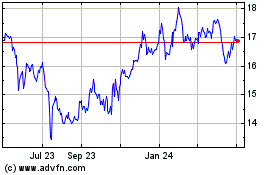AT&T Plans to End 3G Service in 2022 -- WSJ
February 22 2019 - 3:02AM
Dow Jones News
By Drew FitzGerald
This article is being republished as part of our daily
reproduction of WSJ.com articles that also appeared in the U.S.
print edition of The Wall Street Journal (February 22, 2019).
The days of using a 3G cellphone in the U.S. are numbered.
AT&T Inc. said it plans to stop providing service to devices
that use third-generation wireless technology in early 2022 as it
makes room for more powerful standards. The decision, disclosed in
a Wednesday regulatory filing, follows rival Verizon Communications
Inc.'s warning that it will disconnect old 3G cellphones at the end
of this year.
The demise of 3G in the U.S. has been all but certain after
cellphone carriers spent billions of dollars over the past decade
to blanket the country with 4G service. That standard, also known
as long-term evolution, or LTE, allows users to download data 10
times as fast as its predecessor and has paved the way for many
smartphone apps that require ample mobile bandwidth.
Winding down obsolete versions is a habit for telecom companies.
In the 1990s they pushed analog cellphone users to the first
digital standards, and later persuaded 2G users to upgrade to one
of several wireless technologies with the 3G label.
The companies are driven by necessity. Cellphone users with
unlimited data plans stream more video on the go, testing the
limits of what service providers can handle. Getting customers off
3G allows carriers to free up wireless frequencies for 4G signals
over broader swaths of the radio spectrum.
Verizon said in a recent filing it is "aggressively refarming 3G
bands" for 4G but still needs more spectrum to keep up with its
users' demands.
The transitions aren't always smooth. Sprint Corp. shed millions
of customers after it bought Nextel and moved customers off the
acquired company's iDEN push-to-talk technology. Many subscribers
were willing to make the switch, but others were reluctant to hand
in their old walkie-talkie-like devices.
T-Mobile US Inc. said it would avoid past mistakes if it wins
approval for a more than $26 billion purchase of Sprint. Neither
company has disclosed a hard deadline for ending all 3G
service.
Early 3G phones kicked off the smartphone era by giving
customers a reason to use their devices for more than just talking
and texting. Apple Inc.'s cellphone sales took off after it
launched the iPhone 3G.
AT&T said 11% of its postpaid customers were using 3G
service at the end of 2018. More than 85 million devices use 3G,
according to research firm Ovum. They include smartphones, tablets
and devices like vehicle-location trackers. The coming changes
could also affect users of prepaid cellphone brands like TracFone
that use other companies' networks.
Telecom executives are already shifting their attention to the
latest group of engineering standards known as 5G, which are
expected to make video streaming and downloads even quicker. The
specifications also support many more connections at once, allowing
carriers to go after more types of gadgets.
The end of 4G service, if it comes, is far away. Engineers
haven't finished writing 5G standards, and telecom companies say it
will take years to make 5G commonplace. Companies are less
motivated to kill 4G service because it can work in tandem with 5G,
unlike previous generations that forced carriers to devote a band
of wireless spectrum to one technology.
Verizon executive Ronan Dunne told investors at a Thursday
meeting that its 5G service will reach 30 cities this year.
AT&T's 5G service touched parts of 12 cities at the end of
2018, with nationwide service expected in 2020.
Write to Drew FitzGerald at andrew.fitzgerald@wsj.com
(END) Dow Jones Newswires
February 22, 2019 02:47 ET (07:47 GMT)
Copyright (c) 2019 Dow Jones & Company, Inc.
AT&T (NYSE:T)
Historical Stock Chart
From Mar 2024 to Apr 2024

AT&T (NYSE:T)
Historical Stock Chart
From Apr 2023 to Apr 2024
